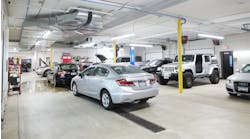Strange weather has been common in many regions across the country, with some areas experiencing heavy flooding or bitter temperatures, no doubt affecting the sales of automotive parts and products. Although some in the industry try not to get too caught up in predictions, others find it important to pay attention.
Craig Bond, vice president of marketing for Bond Auto Parts, says weather “100 percent affects sales,” although his company doesn’t pay much attention to forecasts until a season begins.
“Once we get into the season and (see) it is a mild winter or a mild summer, at that point it affects our cycles in buying or re-buying.”
Bond says items like batteries, lock deicer, windshield wipers and snow machine oil are really affected by weather.
“Last season was a pretty cold year for us and we had a lot of snow. This year was not very cold and we had little snow, so we sold, I think, one quarter of the snow machine oil that we did last year,” he explains.
The company generally experiences mild summers (they have 32 locations throughout Vermont and New Hampshire) so they focus more on appearance chemicals, like car washes and waxes, rather than air conditioning parts.
“We’re not like Florida or Arizona. Our air conditioning business doesn’t exactly go through the roof.” As for sales trends, Bond says the company has more business in the spring, summer and fall because of the nice weather.
“For the DIY aspect of our business, unless you have a heated garage, the chances of you going out and changing your brakes (in the winter) are unlikely.”
Lincoln Collins, president of Mad Hatter Automotive, a 10-year-old auto parts store in Cleveland, Ohio, says he pays attention to the weather when stocking his inventory. Collins receives weekly product shipments.
“Obviously, you should stock up on antifreeze and windshield washer fluid in the winter. And sales do fluctuate if we have a milder winter,” he says. Cleveland had 32.8 inches of snow this January, which was about the same amount as last January.
When it comes to using weather to your advantage, Neal Zipser, vice president of communications for the Motor & Equipment Manufacturers Association (MEMA), says, “(Those) who attempt to understand which weather situations create the most demand and how much demand will come about in those situations are more likely to meet consumer demand in poor weather. For this reason, many parts suppliers and retailers are incorporating long-term weather forecasts in their production and order forecasts.”
Tracking seasonality by region can give manufacturers and even distributors added precision in sales forecasts. In 2000 and 2001, sales climbed to their highest levels in May in the Northeast and Southeast; July on the West Coast; August in the Plains Mountains; September in the South Central region; and October in the Midwest, according to Zipser.
Weather forecasters are putting their tools to the test trying to predict what future seasons of 2005 have in store. Meteorologists at the Climate Prediction Center (CPC), part of the National Oceanic and Atmospheric Administration (NOAA), study 13 seasons (sets of three overlapping months) to gauge temperature and precipitation, says Mike Halpert, head of forecast operations for NOAA’s CPC.
The center updates a set of maps on the third Thursday of every month to show temperature and precipitation forecasts. Each map is available at www.cpc.ncep.noaa.gov/products/predictions/90day.
“The red areas are areas we expect to be above normal temperatures and the blue areas we expect to be below normal temperatures,” Halpert explains. The white areas are labeled EC for “equal chance,” meaning there is nothing yet that indicates those areas will be hotter or colder than normal temperatures for that region. Seasonal maps also show shades of green or brown for areas predicted to be wetter or dryer, respectively. Numbers associated with the shaded areas indicate the probability that the predictions will occur.
Forecasters currently are predicting that Las Vegas has greater than a 60-percent chance of being warmer this spring and summer, Halpert says. CPC reports the mean Las Vegas temperature in the spring is 64.8 degrees Fahrenheit; in the summer, it is 87.6 degrees Fahrenheit.
For spring, warmer temperatures are expected for Northwest and Pacific states like Alaska, Washington, Oregon, California, Idaho, Utah, Nevada and Arizona. Forecasters are predicting cooler than normal temperatures for Northwest and Southwest states like North Dakota, South Dakota, Minnesota, Oklahoma, Texas and Louisiana. For summer, states bordering the West and South coasts are expected to be warmer than usual.
Paul Foley, vice president of the Automotive Aftermarket Suppliers Association (AASA), says that although businesses pay attention to the weather, long-range forecasts could have a negative effect, leaving them stuck with products. Relying more on the short term, and trying to keep inventory levels low and improve reaction times, might be a better way to approach changes in the weather, Foley suggests.
Duke Young, president of Pat Young Services, says his business does pre-season build-up orders, buying “winter goods in winter, summer goods in summer. Certainly this winter has been harsh, and battery sales and snow blades have had a good sales trend,” he says.
When it comes to studying long-term forecasts, however, Young isn’t so sure of their accuracy. “Sometimes you just have to go with your gut on some of this stuff when buying seasonal goods.”


